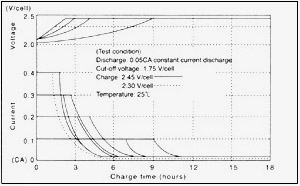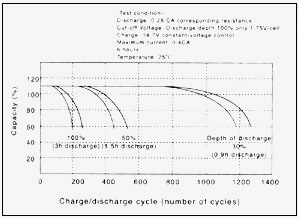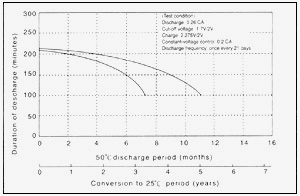Charging
Charge characteristics (constant voltage-constant current charging)of SLA batteries are exemplified below.
Example of constant-voltage charge characteristics by current
In order to fully utilize the characteristics of SLA batteries, constant-voltage charging is recommended.

As shownà
Discharging
a)Discharge current and discharge cut-off voltage
ecommended cut-off voltages for 6v and 12v batteries consistent with discharge rates are given in the figure below. With smaller discharge currents, the active materials in the battery work effectively, therefore discharge cut-off voltages are set to the higher side for controlling overdischarge. For larger discharge currents, on the conrtrary, cut-off voltages are set to the lower side. (Note)Discharge cut-off voltages given are recommended values.
Discharge current vs. Cut-off voltage

b) Discharge temperature
1) Control the ambient temperature during discharge within the range from 5 ° F to 122 ° F(-15℃ to 50℃) for the reason described below.
2) Batteries operate on electrochemical reaction which converts chemical energy to electric energy .The electrochemical reaction is reduced as the temperature lowers, thus, available discharge capacity is greatly reduced at temperature as low as 5 ° F (-15 ℃ ).The high temperature should not exceed 1225 ° F (50 ℃ ) in order to prevent deformation of resin materials which house the battery or deterioration of service life.
c) Effect of temperature on discharge characteristics
Available discharge capacity of the battery varies with ambient temperature and discharge current as shown in the figure below.
Discharge capacity by temperature and by discharge current

d)Discharge current
Discharge capability of batteries is expressed by the 20 hour rate(rated capacity). Select the battery for specific equipment so that the discharge current during use of the equipment falls within the range between 1\20 of the 20 hour rate value and 3 times that (1\20 CA to 3 CA): beyond this range may result in a marked decrease of discharge capacity or reduction in the number of times of repeatable discharge. When discharging the battery beyond said range, please consult DAHUA in advance. (Note) With some types of SLA batteries which have a built-in thermostat, the thermostat may automatically cut off the circuit discharge current exceeds 4 A at the ambient temperature of 104 ° F (40 ℃ ); therefore, the maximum discharge current value should be the smaller one of either 4A or 2 CA.
e)Depth of discharge
Depth of discharge is the state of discharge of batteries expressed by the ratio of amount of capacity discharged to the rated capacity.
Storage
a)Storage condition
Observe the following condition when the battery needs to be stored.
(1) Ambient temperature:5 ° F to 104 ° F (-15 ℃ to 40 ℃ ) (Preferably below 86 ° F (30 ℃ )
(2) Relative humidity:25 to 85%
(3) Storage place free from vibration, dust, direct sunlight and moisture.
b)Self discharge and refresh charge
During storage, batteries gradually lose their capacity due to self discharge, therefore the capacity after storage is lower than the initial capacity .For the recovery of capacity, repeat charge\discharge several times for the battery in cycle use; for the battery in trickle use, continue charging the battery as loaded in the equipment for 48 to 72 hours.
c)Refresh charge (Auxiliary charge)
When it is unavoidable to store the battery for 3 months or longer, periodically recharge the battery at the intervals recommended in the table below depending on ambient t emperature. Avoid storing the battery for more than 12 months.
|
Storage temperature
|
Interval of auxiliary charge(refresh charge)
|
|
Below 68°F(20℃)
|
9 months
|
|
68°F(20℃) to 86°F(30℃)
|
6 months
|
|
86°F(30℃) to 104°F(40℃)
|
3 months
|
d)Residual capacity after storage
The result of testing the residual capacity of the battery which, after fully charged, has been left standing in the open-circuit state for a specific period at a specific ambient temperature is shown in the figure below. The self discharge range is very much dependent on the ambient temperature, it less the self discharge rate almost doubles by each 50 ° F (10 ℃ )rise of storage temperature.
Residual cap ac ity test result
e) Open circuit voltage vs. residual capacity
Residual cap ac ity of the battery can be roughly estimated by measuring the open circuit voltage as shown in the Figure.
Open circuit voltage vs. Residual capacity 77 ° F (25 ℃ )
Temperature conditions
Recommended temperature ranges for charging, discharging and storing the battery are tabulated bel
|
Charge
|
32°F(0℃)~104°F(40℃)
|
|
Discharge
|
5°F(-15℃)~122°F(50℃)
|
|
Storage
|
5°F(0℃)~104°F(40℃)
|
Battery life
a)Cycle life
Cycle life(number of cycles) of the battery is dependent on the depth of discharge in each cycle. The deeper the discharge is ,the shorter the cyc l e life (smaller number of cycles),providing the same discharge current. The cycle life (number of cycles)of the battery is also related to such factors as the type of the battery, charge method, ambient temperature and rest period between charge and discharge. Typical cycle-life characteristics of the battery by different charge\discharge conditions are shown by the below figures.
This data is typical and testes at a well-equipped laboratory.
Cycle times are different for each battery model.
Cycle times are also different from this data when using batteries under real conditions.
Cycle life. Depth of discharge

Constant-voltage cycle life characteristics(DH2.3-12)

Rapid-charge cycle life characteristics(DH2.3-12)

b)Trickle(Float) life
Trickle life of the battery is largely dependent on the temperature condition of the equipment on the temperature condition of the equipment in which the battery is used, and discharge current. The respective Figures show the influence of temperature on trickle life of the battery, an example of trickle(float)life characteristics of the battery, and the test result of the battery life in an emergency lamp.
Influence of Temperature on Trickle life

Trickle life characteristics at122 ° F (50 ℃ )
 Battery terminal
Battery terminal









